COPYRIGHT, PLEASE NOTE
All the material on this website is copyrighted to J-P Metsavainio, if not otherwise stated. Any content on this website may not be reproduced without the author’s permission.
BUY A MUSEUM QUALITY POSTER
BUY A POSTER:https://astroanarchy.zenfolio.com/
Monday, November 24, 2008
The head of the Medusa
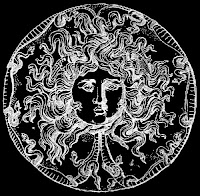
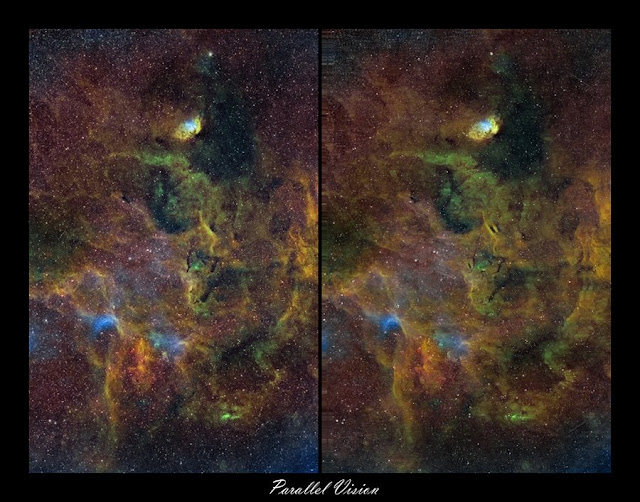
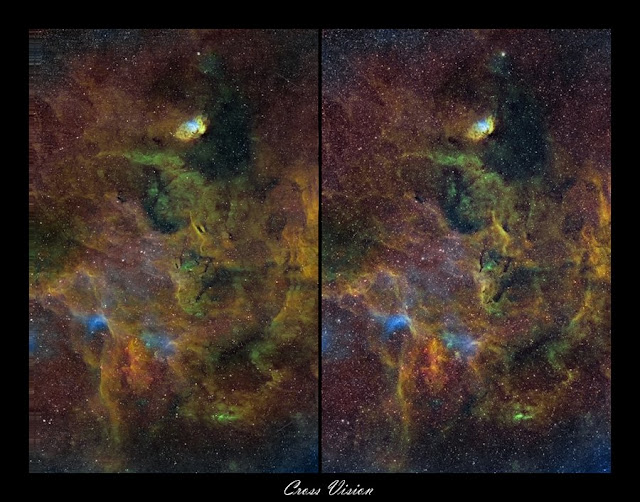
-
I went trough my image archives and noticed some similaritys between
nebulosity near Tulip Nebula and the Medusa in Greec mythology.
I think, similarity is most noticibly in 3D-presentation.
-
Original image and the imaging data can be found here:
-
More information about Medusa can be found here:
-
Labels:
stereo images
Sunday, November 23, 2008
IC405 & IC410 in HST (Hubble Space Telescope) Palette
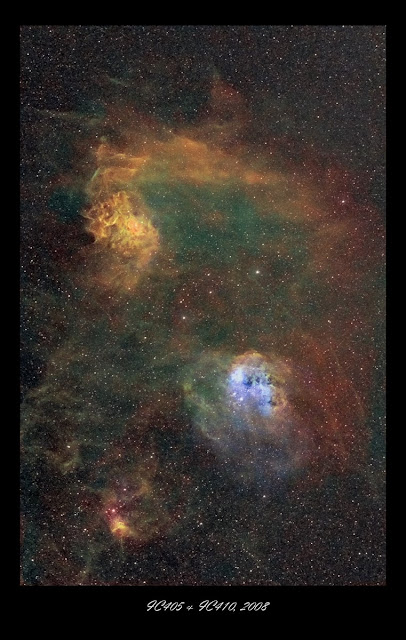 Image in Hubble palette
Image in Hubble palette 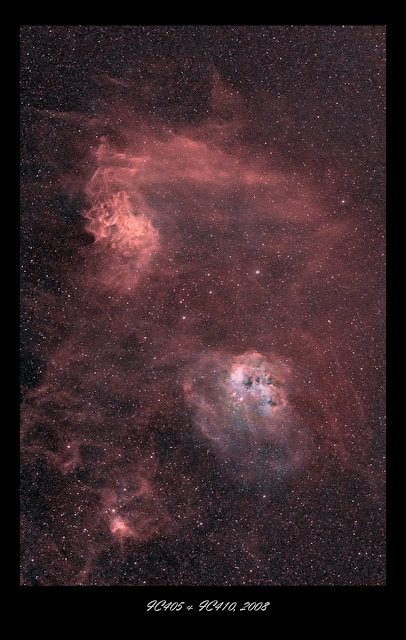 "Natural" color version -
"Natural" color version -
Last night, between and trough speeding clouds, S-II and O-III channels added.
H-alpha data is from November 9, H-a details here:
-
Same imaging data, than in 9.11. image.
Exposures now:
2x1200s S-II (22.11.)
2x1200s O-III (22.11.)
5x1200s H-alpha (09.11.)
IC405 & 410 as a Stero pair
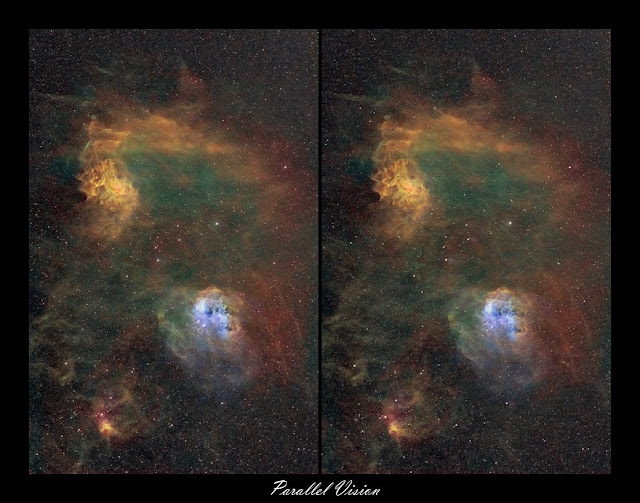
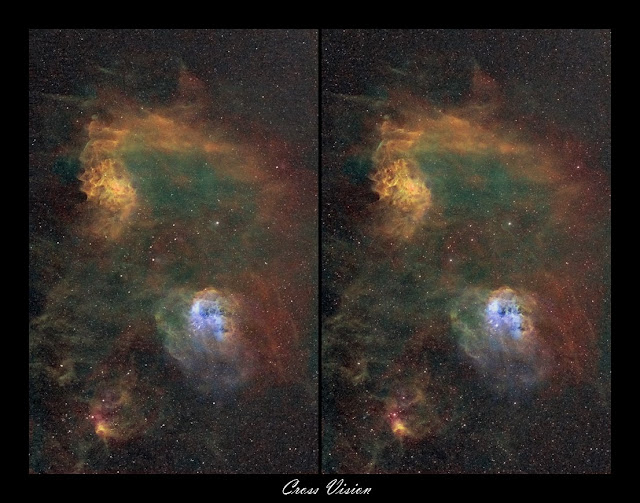
Viewing instructions in the Right hand side menu.
-
If you Have any difficulties to see this image as a stereo one, please, use
your Browser to Zoom image smaller.
Least in IE, zoom button locates in lower Right corner of the Browser.
Labels:
stereo images
Saturday, November 22, 2008
New Version of PS StarAction.
NOTE, link fixed 07.04.2012
New Version Download it HERE
Whats new?
- A new Star Visibility action added. It let you controll the "Star Dominance" in your image by opacity slider.
- In Stereo action there is some minor improvements including an extra step to controll Star visibility. Since there will be one image per eye, the apparent Star brightnes will grow. With this function you can now controll star visibility easily.
- NOTE. If you publish any images processed with the actions, please, could you add a mention, about actions used, in the imaging details, thank you.
Labels:
PS-actions,
research and development
Thursday, November 20, 2008
Sh2-142, color added.
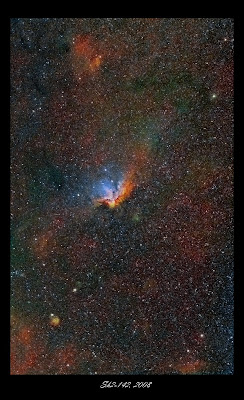
In Hubble Palette
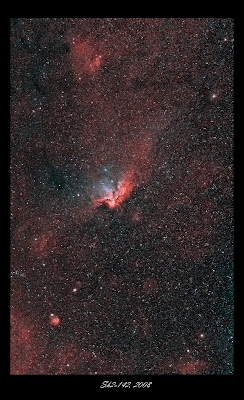

-
S-II and O-III channels added last night.
For H-alpha, there is an additional 1h 20min exposures added to first version
from November 17.
-
Imaging data:
Camera, QHY8
- Filters, Baader 7nm H-alpha, Baader 8,5nm O-III and Baader 8nm S-II
- Optics, Tokina AT-X 300mm @ f2.8
- Exposures, 10X 1200s H-alpha, 2 X 1200 O-III and 2X1200s S-II + flats and bias
- Guiding, LX200 GPS 12" + PHD-guiding and QHY5
Edit.
I looked this image and couldn't figure out what it remainds of.
Now I know!
It looks like a logo of Amnesty International!

Hs2-142 & 157 as a Stereo Pair.
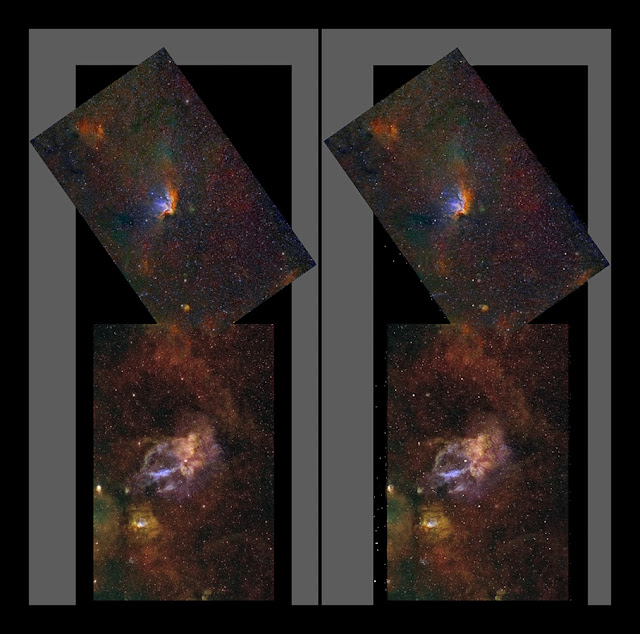
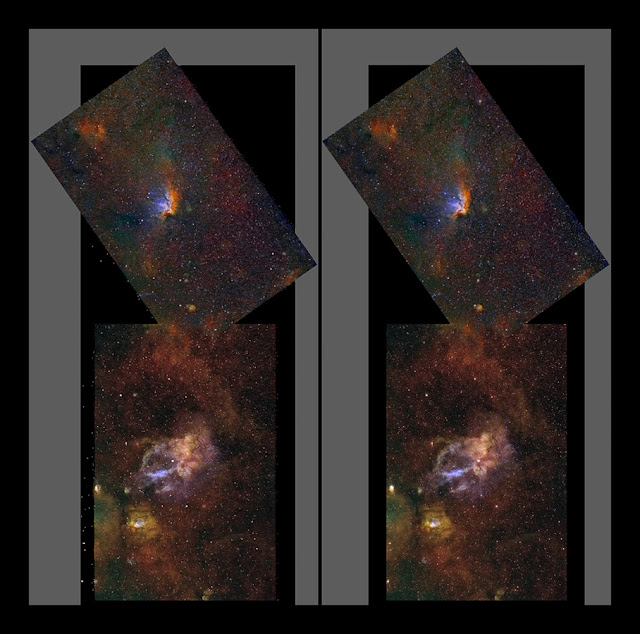
First, "Parallel Vision" and second "Cross Vision" version.
Viewing instructions at Right hand side menu.
Labels:
stereo images
Monday, November 17, 2008
Sh2-157 as a Stereo Pair
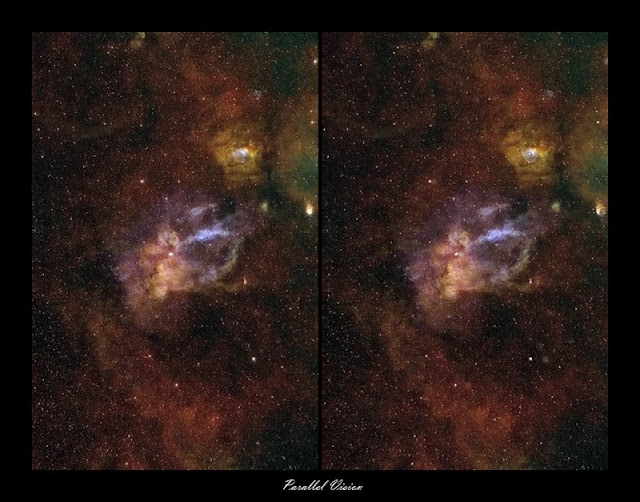
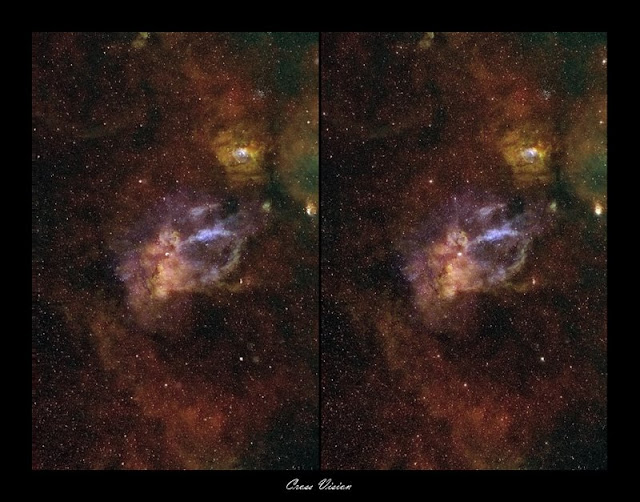
Here we go again, two versions, first for Parallel Vision and
second for Cross Vision method.
Istructions, please, look for the Right hand side menu.
Image info in the original Sh2-157 post.
Labels:
stereo images
From Sharpless Catalog, Sh2-142
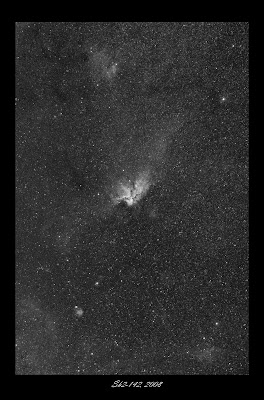
Last night, after long cloudy period, there was three hours opening
in the clouds, so I continued the Sharpless catalog object hunting.
I managed to shot H-alpha channel for Sh2-142 object, seen
in midle of image, hence B&W version.
I'll shoot S-II and O-III channels, when weather up here allows.
-
I made a small mosaic with the previous targets H-alpha
channel to show Sh2-142 and Sh2-157 relative positions to each other.
(Scroll down for Sh2-1157 imaging data)
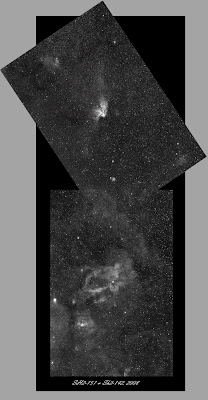
More info, about Sh2-142, can be found here:
-
Imaging data:
Camera, QHY8
- Filters, Baader 7nm H-alpha,
- Optics, Tokina AT-X 300mm @ f2.8
- Exposures, 5X 1200s H-alpha, + flats and bias - Guiding, LX200 GPS 12" + PHD-guiding and QHY5
Sunday, November 16, 2008
Stero Image Pair Action
ACTION REMOVED BY THE AUTHOR.
New version is under construction, might take a while though...
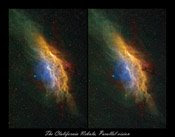 NEW VERSION, Download HERE
NEW VERSION, Download HERE
-Generates two, Parallel and the Cross Vision, versions
- Better star size handling
- Some minor improvements
-
Here is the first version of stereo image Action.
Primary usage is for Nebulae.
Please, let me know if it's working. This is originally made for PS CS3,
but it might work with older version as well.
-
This Action generates a Parallel View version of Stereo Image.
If you need the Cross Vision version, just flip the images in the opposite order,
Left image to Right and Right image to Left.
-
NOTE
This action generates a temporary image in
the C: root named "Starless copy.psd"
You might want to delete it manually later.
NOTE2
This action has to be placed in the same folder with previous "StarRemove1"
action, to make it work right!
-
If some problems occurt, you might like look help from
CloudyNights group, here:
-
-
There has been lots of work to develop this kind of technic.
If you feel, you like to support my work, please, use a donate Button in the Right hand side Menu.
Thank You!
Labels:
PS-actions,
research and development
Friday, November 14, 2008
Star Removal PS action, klick the image to download
OBSOLITE PAGE, PLEASE, DOWNLOAD THE STAR REMOVAL PS ACTION FROM HERE: Star removal PS Action
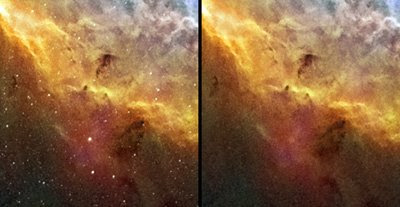
Many astroimagers had asked me to reveal the method of removing Stars.
It's sometimes very usefull to be able to remove stars from the image.
Some dense Starfields can cover nebula details or the Star bloat can cause
problems with narrowband color mixing.
I have now made a PhotoShop Action for StarRemoval!
NOTE! The primary use is for Nebulae!
It might or might not work with Galaxy images
-
It has not been tested, so if there is problems or not, please leave a comment.
There might be some large stars, or fracments of them, in the image
after action. They are easy to remove manually.
The action result can vary, depending many factors, Star size, density, etc...
If you like, you cant tweak the parameter in the action for better result.
Or you can use just some part of the action. Be free to experiment.
-
In my tests I noticed, this works very well to undersampled images >
usuall wide fields one. And there the dence stars are really a problem.
To be sure, that no wanted information is lost, place the starless
image as a layer top of the original and blink.
Then use eraser to restore brighter details.
If you set the transparency, let's say 50%, you can have part of the both worlds.
-
In Cloudynights CCD-imaging group, there is some feedback of this action.
You can find help in there as well, if you have had some problems.
-
-
There has been lots of work to develop this kind of technic.
If you feel, that you like to support my work, please, use a donate Button in the Right hand side Menu.
Thank You!
Labels:
PS-actions,
research and development
Tuesday, November 11, 2008
NGC1499, the "California Nebula" as a Stereo pair
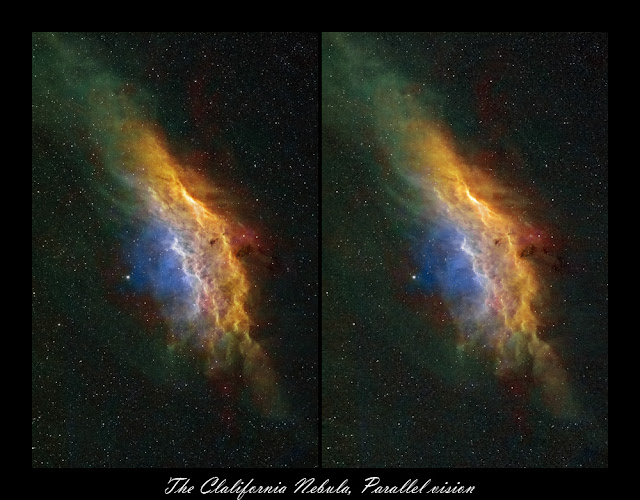
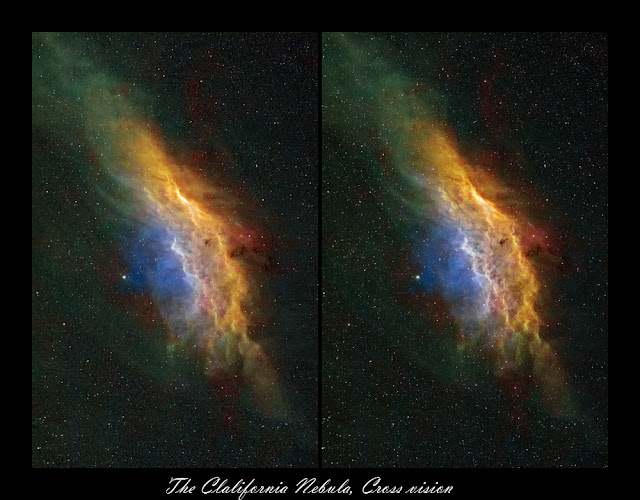
This target reveals new structures in emission line imaging.
I made this presentation to show, how to I see, the structure
of this beautiful nebula.
-
Triple ionized Oxygen (O-III) signal was weak,
it can be seen as a Blue in the image. It seems to reach up to bright
star "Menkib" (HIP18614).
Menkib is energizing the strong emission from NGC1499,
outburs of O-III looks like relating to it.
Very interesting, but I don't know is this well known phenomen.
-
As usual, there is two versions. One for parallel vision, and the other one for cross vision methods. Thats because some part of the viewers can see one of the method in 3D, but not the other. (I can't see cross vision images - How to see this in 3D? Please, look for the right hand side menu for instructions.
 Klick this image, if you can't see either of the stereo methods above. This is a animated image showing steroimage as a small animation. It will gives an idea, what can be seen in stereo images.
Klick this image, if you can't see either of the stereo methods above. This is a animated image showing steroimage as a small animation. It will gives an idea, what can be seen in stereo images.
-
Link to the original imaging data and the image:
Labels:
stereo images
Monday, November 10, 2008
Sh2-157
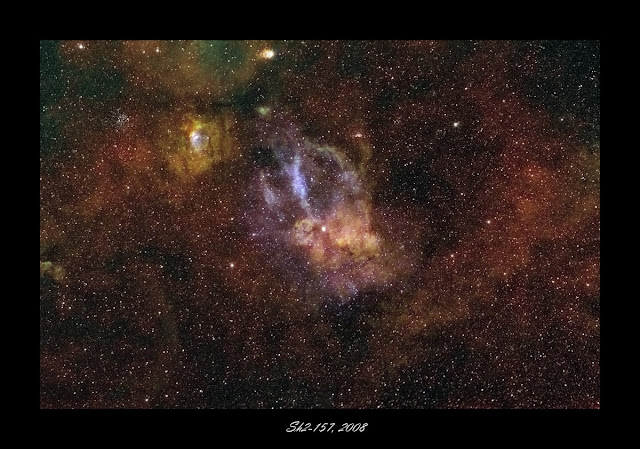
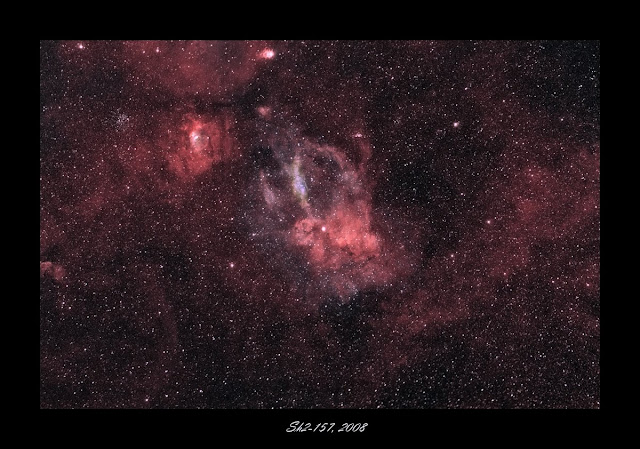
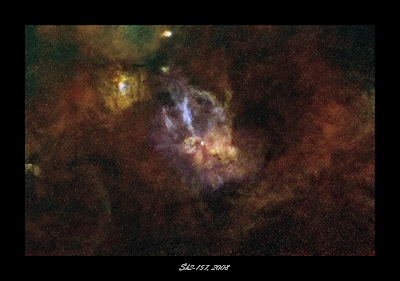
My Sharpless Catalog project continue with Sh2-157.
Sh2-157 is a faint large nebula. Famous Bubble Nebula can be seen in upper left corner.This nebula looks like a gigant termite head to me.
Three versions precented here, first is in a Hubble palette,
second in "natural" colors and
third is an image with reduced stars to better show nebulosity, there seems to be lots offaint double ionized Sulfur (S-II) around.
-
Imaging data: Camera, QHY8 - Filters, Baader 7nm H-alpha, Baader 8,5nm O-III and Baader 8nm S-II - Optics, Tokina AT-X 300mm @ f2.8 - Exposures, 5X 1200s H-alpha, 2 X 1200 O-III and 2X1200s S-II + flats and bias - Guiding, LX200 GPS 12" + PHD-guiding and Lodestar
Sunday, November 9, 2008
IC405 & IC410
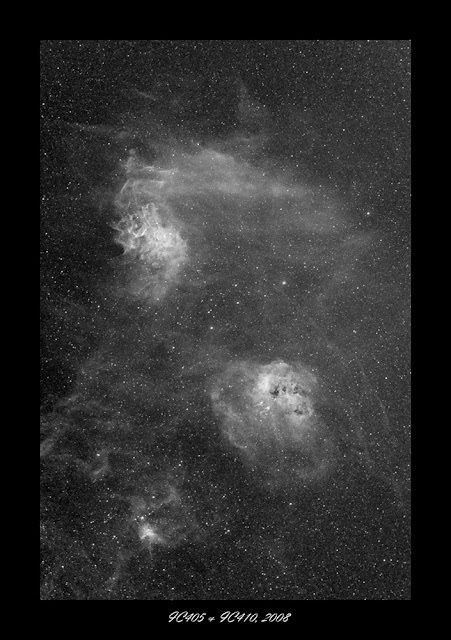
It's nice to make a black and white image
after so colorfull shots.
In the image there is two main objects, IC410 and IC405, sometimes
called as a "Flaming Star Nebula".
IC405 is a emission nebula but it has reflecting nebulosity too.
In my heavily lightpolluted location it's not easy to capture.
Trough Hydrogen alpha filter just emission part is captured.
Some info in Wikipedia: http://en.wikipedia.org/wiki/IC_405
-
Imaging data:
Camera, QHY8 - Filters, Baader 7nm H-alpha - Optics, Tokina AT-X 300mm @ f2.8
- Exposures, 5X 1200s H-alpha + flats and bias - Guiding, LX200 GPS 12" + PHD-guiding and QHY5
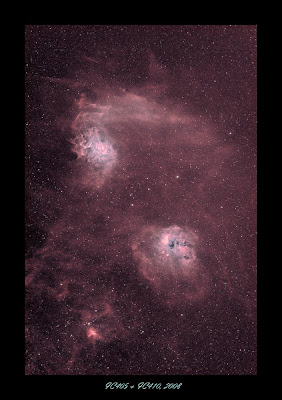 Editted 9.11.
Editted 9.11.
Ok. I can't live without colors, let's face it,
so I added this false color Ha-composition here.
Red = Starless Ha 100% R = 0% B = 17% Ha (Works as a H-beta substitute)
Friday, November 7, 2008
APOD
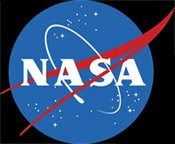
-
-
My "Cygnus Trio" mosaic was selected as an "Astronomy Picture of the Day" by
the NASA.
You can see the NASA page here:
-
-
The Image
Thursday, November 6, 2008
The California Nebula, NGC1499
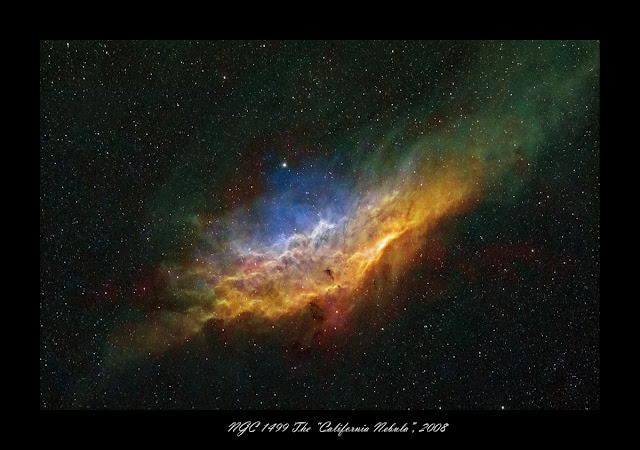 S-II, H-a and O-III composition, Hubble palette
S-II, H-a and O-III composition, Hubble palette 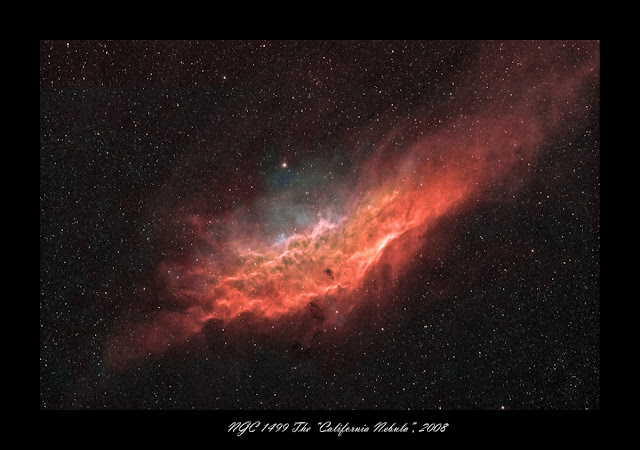 H-a+35%S-II, O-III and O-III+30%H-a, "Natural color" composition
H-a+35%S-II, O-III and O-III+30%H-a, "Natural color" composition 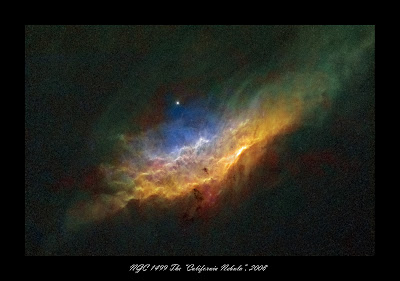
to better show actual nebulosity
-
-
This image looks very different, than images of California Nebula usually do.
There is two reasons.
First is, that this is a three color narrowband image, there is not
too many of them, least I haven't seen one.
Second reason is,
that image is "upside down" compared to usual precentation format.
I did this for a reason, narrowband composition reveals new structures in nebula,
they are very three dimensional and this position shows them best.
-
Imaging data: Camera, QHY8
- Filters, Baader 7nm H-alpha, Baader 8,5nm O-III and Baader 8nm S-II
- Optics, Tokina AT-X 300mm @ f2.8 - Exposures, 5X 1200s H-alpha, 2 X 1200 O-III and 2X1200s S-II + flats and bias
- Guiding, LX200 GPS 12" + PHD-guiding and Lodestar
-
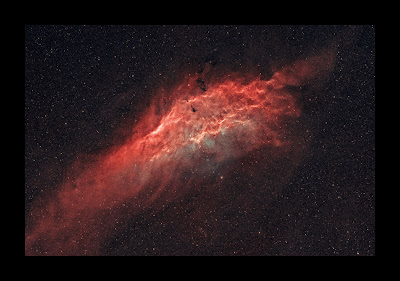
This is how Claifornia Nebula is usually shown.
Thank You!
Thank you!
Your support is very needed to keep up my observatory, art and publishing work.
All my published images can be found from my portfolio
Wednesday, November 5, 2008
Cygnus Trio in Stereo pair
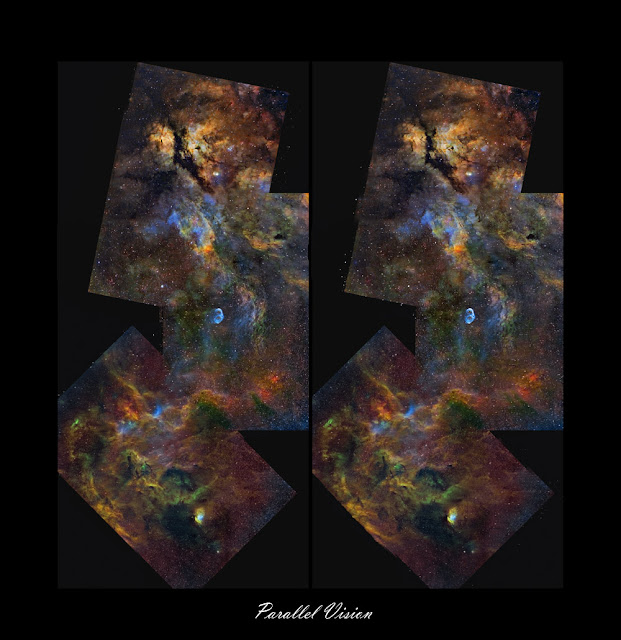
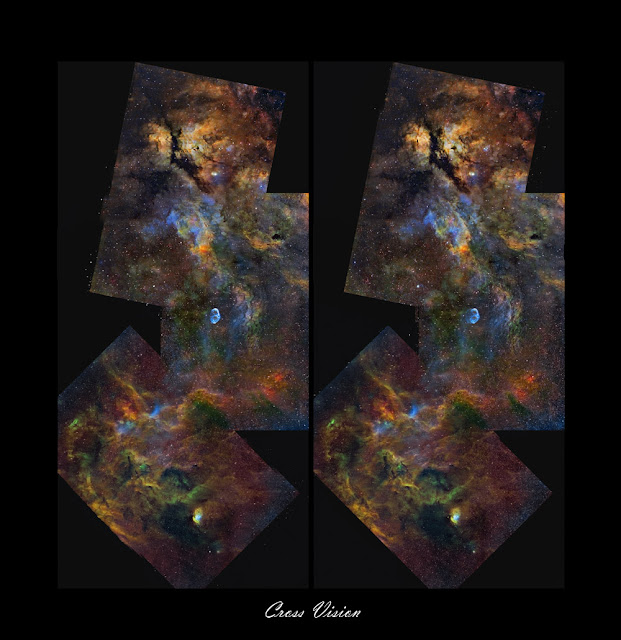
Again, this is not a accurate precentation of actual 3D data.
This is more like a "educated guess"
I made this one to show the actual nature of this target.
The gas and stars are floating in three dimensional space forming three dimensional forms,
rather than being a 2D painting on the canvas.
-
As usual, there is two versions. One for parallel vision, and the other one for cross vision methods. Thats because some part of the viewers can see one of the method in 3D, but not the other. (I can't see cross vision images
-
How to see this in 3D?
Please, look for the right hand side menu for instructions.
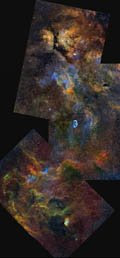 Klick this image, if you can't see either of the stereo methods above.
Klick this image, if you can't see either of the stereo methods above.
This is a animated image showing steroimage as a small animation.
It will gives an idea, what can be seen in stereo images.
Labels:
stereo images
Tuesday, November 4, 2008
The Cygnus Trio, a long project
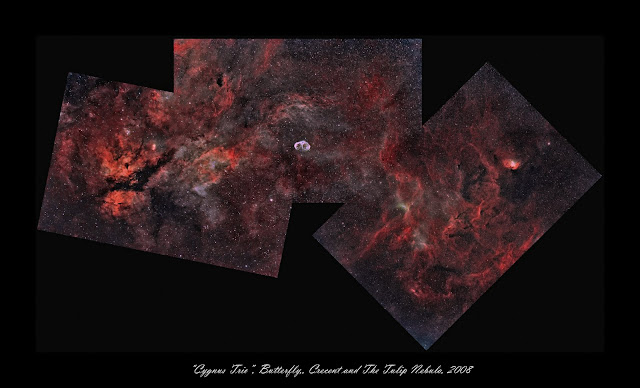
"Natural colors" 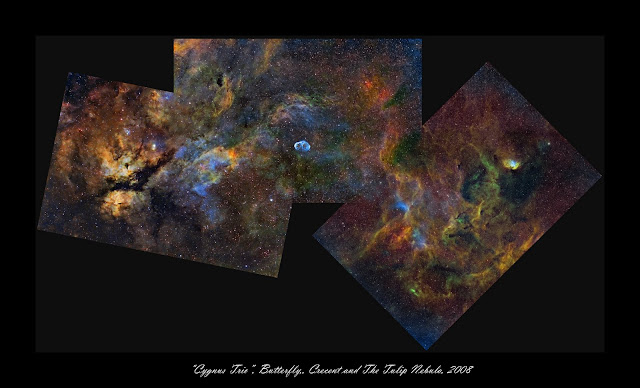 Hubble palette colors -
Hubble palette colors -
 Hubble palette colors -
Hubble palette colors -
The "Cygnus Trio", as I call a chain of objects in constellation Cygnus,
Butterfly nebula, Crescent nebula and finally the Tulip nebula are
located in Milkyway's dense star and gas field.
-
Image here is a mosaic from narrowband images, taken between 29.09-03.11. 2008.
Imaging information can be found in each images original posts.
(look at the right hand side menu, nebula)
The image spans area of 9 x 5 degrees.
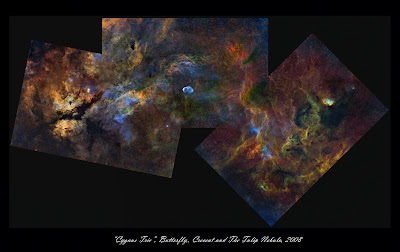 Here is a starless version to show the most complex nebulosity better.
Here is a starless version to show the most complex nebulosity better.The Tulip Nebula
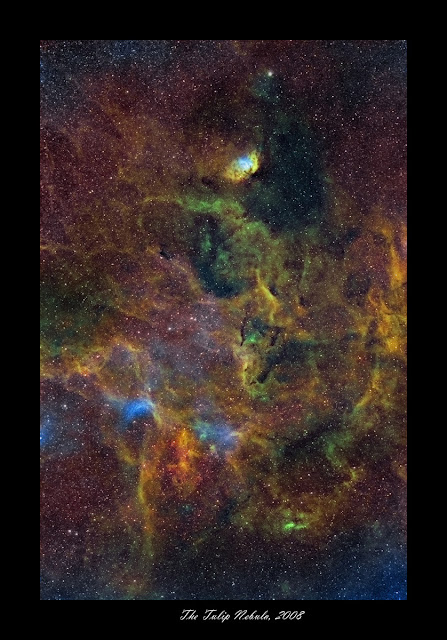
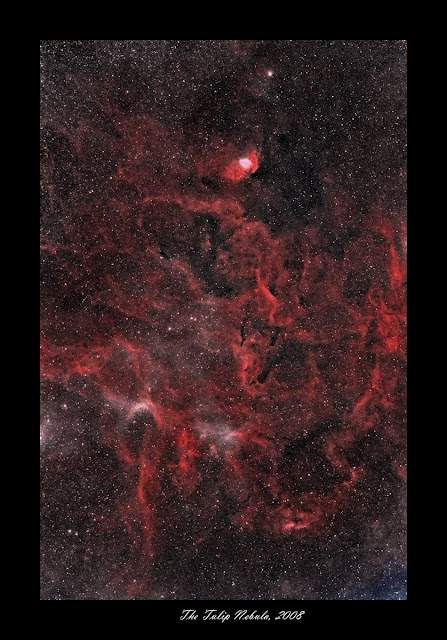
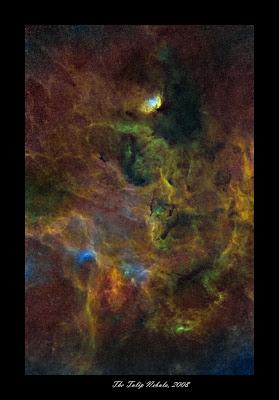
Last image for my Cygnus project is the Tulip nebula.
Image is a narrowband color image in different versions.
There is three version of this image here, first image is Hubble palette composition. S-II =RED, H-alpha = GREEN and O-III = BLUE
Second version is a "natural" color composition from narrowband channels, H-alpha 100% + 35%S-II = RED, O-III = GREEN and O-III 100% + 30%H-alpha = BLUE.
The third version is with suopressed stars to show the complex shapes of the nebula.
-
Imaging data:
Camera, QHY8 - Filters, Baader 7nm H-alpha, Baader 8,5nm O-III and Baader 8nm S-II - Optics, Tokina AT-X 300mm @ f2.8 -
Exposures, 7X 1200s H-alpha, 1 X 1200 O-III and 1X1200s S-II + flats and bias -
Guiding, LX200 GPS 12" + PHD-guiding and Lodestar
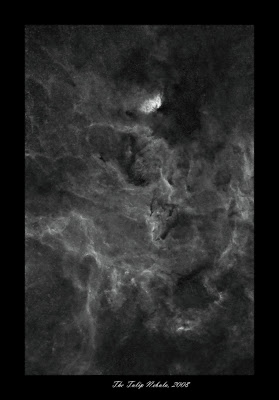
This image is a starless BW version.
It shows a three dimensional nature of this object very well, I think.
Editors' Choice

My Butterfly Nebula image was selected as an "Editors' Choice"
by Sky&Telescope magazine.

Monday, November 3, 2008
NGC6888, the "Crescent Nebula"
 NGC6888 in Hubble palette
NGC6888 in Hubble palette  "natural" color version
"natural" color version  H-alpha channel
H-alpha channel
I imagined the "Butterfly Neula" 29.09.2008.
At the time I left NGC6888 out of the field of view
to be able to better frame the Butterly nebula.
You can see part of the NGC6888 at lower right corner of the Butterly nebula image here:
-
At this time I wanted to capture the Crescent Nebula with the surraunding nebulosity.
NGC6888 is usually seen in longer focallenght images but I found wider field
as interesting doe the colorful and detailed nebula structure.
Imaging data: Camera, QHY8 - Filters, Baader 7nm H-alpha, Baader 8,5nm O-III and Baader 8nm S-II - Optics, Tokina AT-X 300mm @ f2.8 - Exposures, 4X 1200s H-alpha, 3 X 1200 O-III and 2X1200s S-II + flats and bias - Guiding, LX200 GPS 12" + PHD-guiding and Lodestar
-

I made a small mosaic from NGC6888 and the Butterfly Nebula.
The colorful "tale" of the Butterfly spans trough both images.
Subscribe to:
Comments (Atom)














